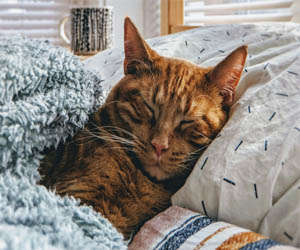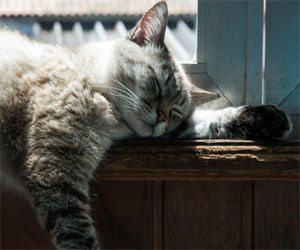


A Guide To Feline Bliss

Cats, those enigmatic and graceful creatures, have a knack for radiating happiness. Their playful antics, purring contentment, and charming quirks have captivated human hearts for centuries. If you've ever wondered about the cat's secret to happiness, this guide will unveil the key components that contribute to their joyful and contented lives.
1. Independence And Freedom
Cats are renowned for their independence, and it's one of the secrets to their happiness. They relish the freedom to explore, hunt, and play at their own pace. As responsible cat guardians, we provide them with a safe environment where they can exercise their natural instincts. Allowing your cat the autonomy to choose when they interact and explore creates a sense of contentment.
2. The Perfect Nap
Cats have mastered the art of napping, and it's a vital ingredient in their happiness. On average, cats sleep 12-16 hours a day, and some even more. These catnaps rejuvenate their energy levels and keep them alert when they're active. Providing a cozy, quiet spot for your cat to rest is essential for their well-being and happiness.
3. Playtime And Stimulation
Cats are playful creatures, and engaging in interactive play is crucial for their happiness. Toys, feather wands, laser pointers, and puzzles all contribute to mental and physical stimulation. Playtime satisfies their natural hunting instincts and provides them with the joy of chasing and pouncing.
4. Grooming And Hygiene
A cat's secret to happiness lies in their meticulous grooming routine. Regular self-grooming keeps their fur clean and helps regulate their body temperature. As cat guardians, we can aid in their happiness by providing the occasional brush to reduce shedding and prevent matting.
5. The Magic Of Purring
The sound of a cat's purring is often associated with contentment and relaxation. Cats purr when they're comfortable, happy, and even when they're in pain, as a self-soothing mechanism. Understanding and responding to their purring can enhance their happiness.
6. Quality Nutrition
Proper nutrition is a significant contributor to a cat's happiness. High-quality cat food that meets their specific dietary needs is essential. Consult with your veterinarian to ensure your cat's diet aligns with their age, activity level, and any health concerns.
7. Safe And Comfortable Environment
Cats find happiness in a safe and comfortable home. Create a hazard-free space, remove toxic plants and chemicals, and offer cozy hideaways where your cat can retreat when they need solitude.
8. Human Companionship
While cats are known for their independence, they also find happiness in human companionship. Building a strong bond with your cat through affection, petting, and communication is essential for their well-being.
9. Routine And Predictability
Cats thrive on routine and predictability. Establishing regular mealtimes, playtime, and bedtime can make your cat feel secure and content.
10. Respect For Their Individuality
Perhaps the most crucial aspect of a cat's happiness is respecting their individuality. Each cat has a unique personality and preferences. Understanding and embracing their quirks and boundaries enhances the bond you share.
The cat's secret to happiness is a combination of independence, freedom, play, quality nutrition, and a loving, secure environment. By providing for their physical and emotional needs, respecting their individuality, and celebrating their charming quirks, you can unveil the key to a joyful and contented feline companion. Cherish every moment with your enigmatic and graceful cat, and you'll witness their happiness radiate into your own life.
Unveiling The Enigmatic Connection

Hypnosis, a state of focused attention and heightened suggestibility, appears to provide a unique gateway to the subconscious mind. In this altered state of consciousness, individuals may be more receptive to suggestions and prompts from a skilled hypnotist, which can be harnessed to access and retrieve memories that are otherwise difficult to recall in a waking state.
One of the most compelling applications of hypnosis in memory retrieval is in the field of forensic psychology. Hypnotic regression, a technique used to guide individuals back to the time of an event they may have forgotten, has been employed to assist witnesses or victims in recalling critical details that can aid in criminal investigations. This technique has been instrumental in helping individuals remember faces, license plate numbers, or specific events that they might have forgotten or suppressed.
Unraveling The Intricate Patterns In Fields
 Historical Roots
Historical Roots
The history of crop circles can be traced back to the early 1970s when the first reports of strange, circular patterns in crops emerged in the English countryside. These early formations were simple circles, far less intricate than the elaborate designs we see today. However, over the years, crop circles have evolved into complex geometric shapes, including spirals, fractals, and even depictions of animals and celestial bodies.
Intricate Geometric Patterns
One of the most striking aspects of crop circles is their precision and intricacy. These formations often display geometric shapes and mathematical properties that challenge conventional explanations. The precision with which they are created has left many experts scratching their heads, as achieving such accuracy in a short amount of time is a challenging feat for human-made formations.
Debates And Skepticism
The origin and purpose of crop circles have sparked numerous debates. Skeptics argue that the majority of crop circles are the result of elaborate hoaxes carried out by artists and pranksters using simple tools, like boards and ropes.






A World Of Skill, Agility, And Bonding
 Obedience competitions, on the other hand, emphasize a dog's ability to follow commands and exhibit self-control. Dogs must perform a series of commands, such as sitting, staying, and heeling, with precision. These competitions not only showcase the dog's obedience but also their intelligence and the training efforts invested by their owners.
Obedience competitions, on the other hand, emphasize a dog's ability to follow commands and exhibit self-control. Dogs must perform a series of commands, such as sitting, staying, and heeling, with precision. These competitions not only showcase the dog's obedience but also their intelligence and the training efforts invested by their owners.
Herding trials are an excellent example of competitions that tap into a dog's innate instincts. Breeds such as Border Collies and Australian Shepherds excel in these trials, as they are natural herders. In these contests, dogs are tasked with herding a group of livestock through a course, demonstrating their herding skills, control, and adaptability.
Retrieving trials are designed for breeds known for their retrieving abilities, such as Labrador Retrievers and Golden Retrievers. These competitions involve tasks like retrieving a dummy or an object from water, showcasing the dog's strength, swimming ability, and willingness to retrieve objects for their owner.
Apart from honing a dog's physical and mental abilities, canine competitions offer numerous benefits. For dogs, they provide essential exercise and mental stimulation, contributing to their overall well-being. These competitions also foster socialization, as dogs interact with other canines and their owners, helping them become more well-adjusted pets.
For dog owners, participating in canine competitions is an opportunity to deepen their bond with their furry friends. The trust and teamwork required to excel in these events create a unique connection between the two, enhancing their companionship. It's a chance for owners to learn more about their dog's capabilities and build a stronger, more harmonious relationship.
Deciphering Cat Sleeping Patterns
 1. Cats Are Natural Sleepers: Cats are crepuscular animals, which means they are most active during dawn and dusk. Their natural hunting instincts dictate their active periods, and they typically sleep during the day and night. A cat's need for sleep is deeply ingrained in their biology, and they can sleep anywhere from 12 to 16 hours a day, depending on factors like age and activity level.
1. Cats Are Natural Sleepers: Cats are crepuscular animals, which means they are most active during dawn and dusk. Their natural hunting instincts dictate their active periods, and they typically sleep during the day and night. A cat's need for sleep is deeply ingrained in their biology, and they can sleep anywhere from 12 to 16 hours a day, depending on factors like age and activity level.
2. The Power Napper: Cat sleep is characterized by numerous short naps rather than one long, continuous sleep cycle. This style of sleeping is believed to be rooted in their wild ancestry, where they needed to remain vigilant to avoid predators or catch prey at a moment's notice.
3. Comfort Is Key: Cats seek comfort and safety in their choice of sleep locations. You may find your cat curling up in sunny spots to keep warm or seeking out secluded, high-up locations where they can rest undisturbed. Cardboard boxes, windowsills, and cozy nooks are all popular cat nap spots.
4. Cats Dream Too: Like humans, cats experience different stages of sleep, including REM (Rapid Eye Movement) sleep, during which they may dream. You might notice their paws twitching or their whiskers quivering during REM sleep, suggesting that they're actively dreaming.
5. Kittens Sleep More: Kittens and young cats require more sleep than their adult counterparts, with some kittens sleeping as much as 20 hours a day. This extended sleep period is essential for their rapid growth and development.
6. Factors Influencing Sleep: A cat's sleeping patterns can be influenced by several factors, including their health, age, environment, and routine. Changes in any of these areas can impact their sleep habits. Stress, illness, or discomfort can also affect the quality and duration of their sleep.
Paving The Way To A Sustainable Future
 A Response To Environmental Challenges: The world faces unprecedented environmental challenges, from rising greenhouse gas emissions to air pollution and resource depletion. Clean energy solutions provide a viable response to these issues by harnessing energy sources that produce little to no harmful emissions.
A Response To Environmental Challenges: The world faces unprecedented environmental challenges, from rising greenhouse gas emissions to air pollution and resource depletion. Clean energy solutions provide a viable response to these issues by harnessing energy sources that produce little to no harmful emissions.
Diverse Technologies:
Clean energy solutions encompass a wide array of technologies, with each catering to specific needs and geographic conditions. Some of the most prominent options include:
Solar Energy: Solar panels harness the power of sunlight and convert it into electricity. This technology has seen remarkable advancements, with increased efficiency and decreasing costs.
Wind Energy: Wind turbines capture kinetic energy from the wind and convert it into electricity. Wind farms, both onshore and offshore, have become a common sight in many parts of the world.
Hydropower: Hydropower plants utilize the energy of flowing water to generate electricity.
Exploring Self-Hypnosis Techniques
 Self-hypnosis, also known as autohypnosis, empowers individuals to enter a hypnotic state on their own, without the assistance of a hypnotist. It can be a valuable tool for relaxation, personal growth, and addressing specific challenges. Here are some key self-hypnosis techniques to consider:
Self-hypnosis, also known as autohypnosis, empowers individuals to enter a hypnotic state on their own, without the assistance of a hypnotist. It can be a valuable tool for relaxation, personal growth, and addressing specific challenges. Here are some key self-hypnosis techniques to consider:
Find A Quiet Space: Begin by selecting a quiet, comfortable space where you can relax without distractions. Whether it's a cozy chair, a soft carpet, or even your bed, the key is to ensure you won't be interrupted during your self-hypnosis session.
Set An Intention: Determine the purpose of your self-hypnosis session. What specific issue or goal would you like to address or achieve? Having a clear intention will guide your self-hypnosis process.
Relaxation And Breathing: Sit or lie down in a comfortable position. Close your eyes and take a few deep, cleansing breaths. With each exhalation, release tension and stress. Slow, deep breathing can help induce a state of relaxation.
Visualization: Begin to visualize a calming and serene place. This could be a beach, a forest, or any location where you feel at peace. Imagine the sights, sounds, and sensations of this place. Visualization helps deepen your relaxation.
Progressive Muscle Relaxation: Progressively tense and then release the tension in each muscle group in your body, starting from your toes and moving upward. This can enhance your state of physical relaxation.
Affirmations And Suggestions: With your mind in a receptive state, use positive affirmations and suggestions related to your intention. For example, if you're seeking stress relief, you might say, "I am calm and in control." Repeat these affirmations while maintaining focus on your intention.
Counting Down: Some individuals find it helpful to count down from a specific number, such as 10 to 1, as they enter a deeper state of relaxation. This counting can serve as a trigger for your subconscious mind.